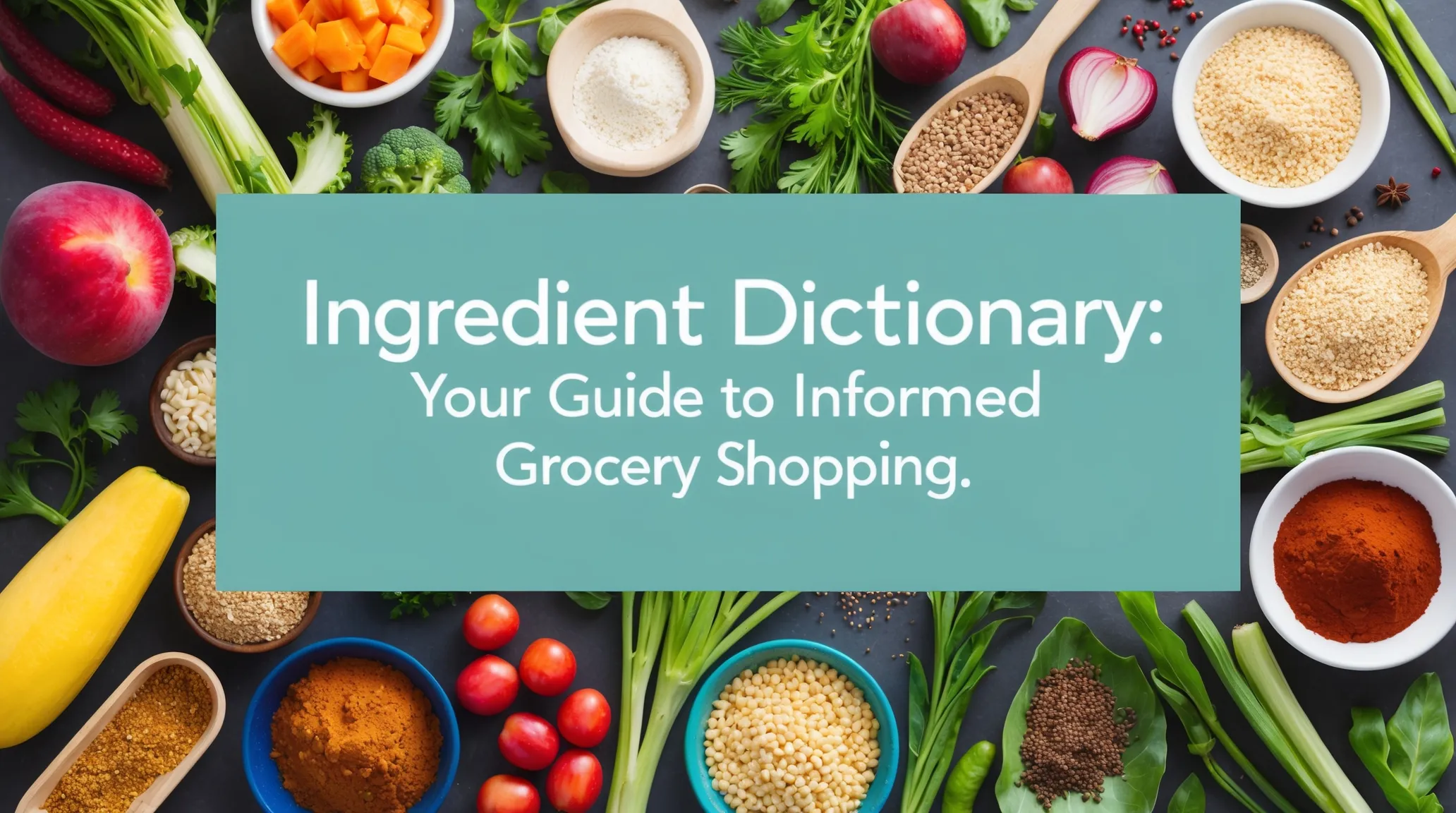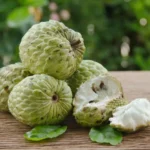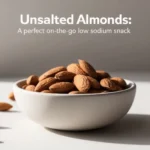Understanding Nutritional Benefits
In today’s fast-paced world, understanding the nutritional benefits of the ingredients you choose during grocery shopping has become increasingly complicated. As you put in the effort to create a detailed shopping list, do you truly comprehend what each ingredient contributes to your body? Even if you manage to find everything on your list, it’s essential to know how these items impact your health and well-being
Given all these buzz words such as ‘ adaptogen’ and more sources for antioxidants and proteins than you thought possible, it is understandable why many would get confused.
Wouldn’t it be great to have a straight to the point, easy to read glossary which states what you are looking for as well as what you are taking? Good news, we made one!
We searched the Web, spoke to a medical specialist, and even to you, trying to find out what uncommon ingredients you would like to know about.
Hold this guide with you when you are going to go through the grocery store, and you will be well prepared and armed with all the information that will enable you to eat healthy.
I will start from scratch and rewrite the entire list provided in the document you uploaded and be careful not to plagiarize and create fresh content summarized in one’s work. This is how the narrative shifted in the starting rewritten portion of the work.
Exploring Ingredients and Their Nutritional Benefits

A-D Ingredients:
Agar-Agar
Scientific Evidence: Nutritional benefits confirmed. New research consideration about further options.
Agar-agar is a gelatin derived from red algae and is commonly used as a thickening agent in cooking and candy making. It is a perfect replacement for animal-derived gelatin in vegan desserts and can also be used instead of xanthan gum. Though the substance offers little in regards to general health, minerals such as calcium can be found in trace amounts in it.
Acai
Scientific Evidence: Nutritional claim is valid (has a value), insatiable additional benefits warrant further studies.
These Central and South American little grey berries have an interesting taste combining blackberries and unsweetened pure chocolate. Anthocyanin (antioxidants) is the reason for acai’s deep purple coloration which is also contained in the blueberries. Acai is available in powder form, supplements and real berry forms which is sometimes advertised as superfruit even though further studies are needed to fully support the claims.
I’ll begin rewriting the entire list from the document you uploaded, making sure the content is original, non-plagiarized, and comprehensive. Here’s the start of the rewritten content.
Acacia Gum
Scientific Evidence: Nutritional benefits confirmed, emerging research on health benefits.
Acacia gum is a common food additive used to stabilize and thicken food, enhancing its texture. Although safe for consumption, ongoing research suggests that it may provide certain health benefits when consumed in large doses.
Acerola Cherry
Scientific Evidence: Nutritional value confirmed, limited data on broader benefits.
Also known as Barbados or West Indies cherry, acerola cherries are a fantastic source of Vitamin C, particularly in tropical regions. Although some claim it improves digestion and mental health, scientific evidence supporting these claims is limited.
Acesulfame Potassium
Scientific Evidence: Research is mixed.
Acesulfame potassium is a calorie-free sweetener, about 200 times sweeter than sugar, often used in soft drinks and other sweetened products. Although FDA-approved, some studies suggest potential health risks such as hormone disruption and cancer, though these findings have been contested.
Acidity Regulators
Scientific Evidence: Mixed findings.
These food additives are primarily used to control the acidity of food, enhancing flavor. While certain regulators like sodium nitrate have been linked to potential health risks, others, such as sodium benzoate, are generally recognized as safe.
Activated Charcoal
Scientific Evidence: Limited research.
Activated charcoal is a type of charcoal treated with oxygen at high temperatures, traditionally used for its detoxifying properties. It is believed to aid in kidney health and reduce cholesterol, although more research is required to substantiate these claims.
Adzuki Beans
Scientific Evidence: Confirmed nutritional value, limited research on additional benefits.
Adzuki beans, often used to make sweet bean paste, are rich in fiber, protein, and complex carbohydrates. Some studies suggest they may aid digestion, support heart health, and even contribute to weight loss, although more research is needed to confirm these benefits.
Annatto
Scientific Evidence: Emerging research on health benefits.
Derived from the seeds of the achiote tree, annatto is often used for its vibrant orange-red color in food. It contains carotenoids and flavonoids, which may have antioxidant and antimicrobial properties, although research is still in the early stages.
Almond Oil
Scientific Evidence: Well-supported by research.
Almond oil, extracted from pressed almonds, is rich in Vitamin E and has anti-inflammatory and heart-healthy properties. It’s a great addition to both culinary and cosmetic applications, with robust evidence supporting its benefits.
E-H Ingredients:
Edible Gold
Scientific Evidence: No health benefits supported.
Edible gold is used purely for decorative purposes in foods, typically to give a luxurious appearance to desserts and other dishes. While it’s safe for consumption, it provides no nutritional or health benefits.
Elderberry
Scientific Evidence: Nutritional value confirmed, research on additional benefits emerging.
Used for centuries in traditional medicine, elderberry is rich in Vitamin C and antioxidants. It’s commonly touted for its immune-boosting properties and is popular as a natural remedy for colds and flu, although larger studies are still needed to validate these claims.
Endive
Scientific Evidence: Nutritional value confirmed, emerging research on additional benefits.
Endive is a leafy green vegetable packed with antioxidants like kaempferol, which may have anti-cancer properties. Further research is required to confirm its broader health benefits in humans.
Enoki Mushrooms
Scientific Evidence: Nutritional value confirmed, emerging research on health benefits.
Enoki mushrooms are rich in B vitamins such as niacin, pantothenic acid, and thiamine. They may support heart and brain health, and early studies suggest they may help fight cancer, though further human studies are needed.
Fennel
Scientific Evidence: Confirmed nutritional value, mixed results on health benefits.
Fennel and its seeds contain Vitamin C, magnesium, potassium, and other nutrients that support heart health. Although some research suggests fennel may help with appetite control and cancer prevention, results in human studies are inconclusive.
Fenugreek
Scientific Evidence: Nutritional value supported, limited research on other benefits.
Fenugreek is an herb that has been used in traditional medicine, especially for boosting lactation in nursing mothers. While it may also help with blood sugar and cholesterol control, more studies are needed to validate these potential benefits.
Ferrous Gluconate
Scientific Evidence: Well-supported by research for nutritional value.
Ferrous gluconate is a form of iron commonly prescribed for treating anemia. It’s also used in fortified foods like cereals and baby formula to boost iron intake.
Fish Oil
Scientific Evidence: Strong support for health benefits.
Fish oil, rich in omega-3 fatty acids, is widely recognized for its heart health benefits, as well as its potential to reduce inflammation, improve mental health, and support eye health.
Freekeh
Scientific Evidence: Well-supported for health benefits.
Freekeh is an ancient grain made from green durum wheat. It’s high in fiber and may aid digestion, promote heart health, and assist in weight management. However, it contains gluten, making it unsuitable for those with gluten sensitivities.
Fresno Chilies
Scientific Evidence: Nutritional value confirmed, limited research on additional benefits.
Fresno chilies are medium-hot peppers that contain capsaicin, a compound known for its potential pain-relieving and weight-loss properties. However, consuming too much chili may worsen symptoms for people with irritable bowel syndrome.
Fugu
Scientific Evidence: No supported health benefits.
Fugu, or pufferfish, is a Japanese delicacy that requires expert preparation due to its potentially lethal toxin, tetrodotoxin. While it’s a traditional dish, there are no particular health benefits associated with its consumption.
Galangal Root
Scientific Evidence: Nutritional value confirmed, research on additional benefits emerging.
Galangal is a Southeast Asian spice that has been used in traditional medicine for its anti-inflammatory and infection-fighting properties. Emerging research suggests it may help with male fertility and cancer prevention, but more human studies are needed.
Ginger Root
Scientific Evidence: Nutritional value confirmed, mixed research on broader benefits.
Ginger is widely used for its medicinal properties, especially in reducing nausea, indigestion, and inflammation. While some studies support its effectiveness in treating conditions like osteoarthritis and diabetes, more large-scale studies are needed to confirm these benefits.
Goji Berries
Scientific Evidence: Nutritional value supported, emerging research on additional benefits.
Goji berries are nutrient-dense fruits rich in antioxidants, especially Vitamin C. They’re often marketed as a superfood that boosts immune function and eye health, although further research is needed to validate these claims.
Ginseng
Scientific Evidence: Strong evidence for nutritional value, emerging research on broader benefits.
Ginseng is a well-known herb in traditional medicine, believed to support immune health, boost energy, and improve mental function. Although promising studies suggest it may help with conditions like cancer and erectile dysfunction, more research is required.
Gluten
Scientific Evidence: Confirmed nutritional value, additional research emerging.
Gluten is a protein found in wheat, barley, and rye. While safe for most people, those with celiac disease or gluten sensitivity should avoid it. There is ongoing research into the health implications of gluten, especially in relation to non-celiac individuals.
Gochujang
Scientific Evidence: Nutritional value confirmed, no additional research.
Gochujang is a Korean chili paste made from fermented soybeans, glutinous rice, and red chili powder. It’s a staple ingredient in Korean cooking, known for adding spicy, umami-rich flavor to dishes.
I-L Ingredients:
Ikan Bilis
Scientific Evidence: Nutritional value confirmed.
Ikan bilis, or anchovies, are small fish commonly used in Southeast Asian cuisine. These fish are nutrient-dense, providing omega-3 fatty acids, calcium, iron, and selenium, all of which are beneficial for heart and brain health.
Iberian Ham
Scientific Evidence: Nutritional value confirmed, limited research on broader benefits.
Iberian ham comes from a specific breed of pigs that graze on acorns, grass, and herbs, resulting in a unique flavor. Though it’s lower in unhealthy fats than other types of ham, research into its potential health benefits is still limited.
Inulin
Scientific Evidence: Generally considered safe (GRAS), limited research on additional benefits.
Inulin is a type of fiber found in foods like asparagus, bananas, and onions. It acts as a prebiotic, supporting gut health and possibly helping to manage blood sugar. However, more studies are needed to confirm its broader health effects.
Jackfruit
Scientific Evidence: Nutritional value confirmed, mixed research on additional benefits.
Jackfruit is a tropical fruit packed with nutrients such as vitamin C and antioxidants. It may help control blood sugar and support immune health, but more research is needed to confirm its benefits related to heart health and skin conditions.
Jaggery
Scientific Evidence: Nutritional value confirmed, no additional health benefits.
Jaggery is an unrefined sugar that contains more nutrients than white sugar. However, the amount of jaggery needed to benefit from these nutrients would be impractically high due to its calorie content, so it’s best consumed in moderation.
Jicama
Scientific Evidence: Nutritional value confirmed.
Jicama is a low-calorie, high-fiber root vegetable that contains essential nutrients like vitamin C, folate, and potassium. It may promote digestion, heart health, and reduce the risk of chronic diseases.
Kamut
Scientific Evidence: Nutritional value confirmed, emerging research on additional benefits.
Kamut, also known as Khorasan wheat, is a nutrient-dense grain high in fiber. It may help regulate blood sugar and reduce heart disease risk, though more large-scale studies are needed to validate these benefits.
Kava
Scientific Evidence: Nutritional value confirmed, emerging research on health benefits.
Kava, a traditional beverage in the Pacific Islands, is gaining popularity for its potential to reduce anxiety and stress. Research supports its calming effects, but concerns remain about its safety when consumed in large quantities or over long periods.
Kiwano
Scientific Evidence: Nutritional value confirmed.
Also known as horned melon, kiwano is rich in antioxidants like lutein and vitamins A, C, and E. It may help with hydration, blood sugar regulation, and immune function, but research is still in its early stages.
Kudzu Root
Scientific Evidence: Nutritional value confirmed, limited research on health benefits.
Kudzu root is commonly used in Traditional Chinese Medicine to treat ailments such as liver damage and menopause symptoms. Though promising, more human studies are needed to support these benefits.
L-Theanine
Scientific Evidence: Nutritional value confirmed, emerging research on health benefits.
L-theanine is an amino acid most commonly found in tea, particularly green tea. It is thought to help reduce stress and improve sleep, and early studies suggest it may support cognitive function, though larger trials are needed.
Lactic Acid

Scientific Evidence: Nutritional value confirmed, mixed research on broader benefits.
Lactic acid is commonly found in fermented foods and may help improve gut health and nutrient absorption. Some studies suggest it can cause digestive issues in sensitive individuals, so more research is needed to determine its overall impact.
Lard
Scientific Evidence: No confirmed health benefits.
Lard, a semisolid fat from pigs, is used in baking and cooking for its rich flavor and creamy texture. It’s high in saturated fat, which is linked to heart disease. Healthier alternatives like butter or vegetable oils are often recommended.
Loquats
Scientific Evidence: Nutritional value confirmed, emerging research on broader benefits.
Loquats are small, sweet fruits packed with carotenoid antioxidants that can improve eye health. They also contain phenolic compounds that may protect against chronic diseases like diabetes and certain cancers, but more human studies are needed.
Longan Fruit
Scientific Evidence: Nutritional value confirmed, mixed research on health benefits.
Longan fruit is rich in Vitamin C and fiber, which support immune function and digestive health. While some people claim it can reduce stress and fatigue, evidence for these effects is mostly anecdotal, with few scientific studies backing it up.
Locust Bean Gum
Scientific Evidence: Generally recognized as safe (GRAS), confirmed health benefits.
Locust bean gum is a vegan thickener and food stabilizer made from carob seeds. It’s high in fiber and may help regulate blood sugar and cholesterol levels, though excessive consumption can cause digestive upset in some individuals.
M-P Ingredients:
Maca Root
Scientific Evidence: Nutritional value confirmed, limited research on health benefits.
Maca root, a cruciferous vegetable from Peru, has been used for centuries as both food and medicine. It’s known for its potential to boost energy, fertility, and libido, though more research is required to substantiate these claims in larger populations.
Maltodextrin
Scientific Evidence: Generally recognized as safe (GRAS), no health benefits.
Maltodextrin is a common food additive used to increase thickness and bulk in processed foods. Although safe to consume, it is high in carbohydrates and may cause blood sugar spikes, making it unsuitable for those with diabetes.
Matcha
Scientific Evidence: Nutritional value confirmed, emerging research on additional benefits.
Matcha, a powdered form of green tea, contains higher concentrations of caffeine and antioxidants than regular green tea. It may support heart health, aid in weight management, and improve brain function, but more extensive studies are needed to confirm these benefits.
Matsutake Mushrooms
Scientific Evidence: Nutritional value confirmed, emerging research on health benefits.
Matsutake mushrooms are rich in fiber and vitamins, and early studies suggest they may help lower cholesterol and support cancer prevention. However, more human trials are needed to validate these claims.
Mesquite
Scientific Evidence: Nutritional value confirmed, limited research on additional benefits.
Mesquite is a natural sweetener derived from the pods of the mesquite tree. It has a low glycemic index, making it a good option for those managing blood sugar levels, but research on its broader health benefits is limited.
Moringa
Scientific Evidence: Nutritional value confirmed, limited research on health benefits.
Moringa is a nutrient-dense plant known for its anti-inflammatory and antioxidant properties. It may also help lower cholesterol and blood sugar levels, though more research is needed to confirm its full range of benefits.
MSG (Monosodium Glutamate)
Scientific Evidence: Generally recognized as safe (GRAS), mixed research on health effects.
MSG is a flavor enhancer widely used in processed foods and Asian cuisine. Despite past claims linking it to negative health effects, modern research suggests that it’s safe for most people when consumed in moderation.
Mustard Oil
Scientific Evidence: Nutritional value confirmed, mixed research on health benefits.
Mustard oil is a popular cooking oil in South Asia, containing omega-3 fatty acids. While it may have anti-inflammatory and heart-healthy properties, studies on its long-term effects are inconclusive, and some countries restrict its use due to potential health risks.
Nopal Cactus
Scientific Evidence: Nutritional value confirmed, emerging research on health benefits.
Nopal cactus, also known as prickly pear, is often used in traditional Mexican dishes. It’s rich in fiber and antioxidants, and emerging research suggests it may help regulate blood sugar, cholesterol, and reduce oxidative stress.
Nori
Scientific Evidence: Nutritional value confirmed, mixed research on health benefits.
Nori is a type of dried seaweed commonly used in sushi. It’s a good source of iodine and may support thyroid health. While it contains B12, there is debate about how well the body can absorb this form of the vitamin from seaweed.
Nutritional Yeast
Scientific Evidence: Nutritional value confirmed, emerging research on additional benefits.
Nutritional yeast is a vegan-friendly source of protein and B vitamins. It may help lower cholesterol and boost immune health, although more research is needed to confirm these potential benefits.
Okra
Scientific Evidence: Nutritional value confirmed, mixed research on health benefits.
Okra is a low-calorie fruit often used as a vegetable in cooking. It’s rich in vitamin C and K1, which are essential for immune function and blood clotting. Though some studies suggest it may support heart health and blood sugar regulation, more research is needed to confirm these claims.
Oxalates
Scientific Evidence: Nutritional value confirmed.
Oxalates are naturally occurring compounds found in plants that can bind to minerals like calcium. In large amounts, oxalates may contribute to kidney stones, but they are also important for plant protection.
Palm Oil
Scientific Evidence: Nutritional value confirmed, emerging research on broader benefits.
Palm oil is widely used in processed foods and is high in fats, particularly vitamin E. Although some studies suggest it may improve brain function and reduce heart disease risk, its environmental impact has made it controversial.
Pantothenic Acid
Scientific Evidence: Strong support for nutritional value.
Pantothenic acid, also known as vitamin B5, is essential for producing red blood cells and converting food into energy. It is commonly found in broccoli, whole grains, and cabbage.
Passionflower
Scientific Evidence: Nutritional value confirmed, limited research on broader benefits.
Passionflower is often used in teas and supplements for its purported ability to alleviate anxiety, insomnia, and pain. While early studies are promising, more data is needed to confirm its effectiveness in humans.
Pattypan
Scientific Evidence: Nutritional value confirmed, no specific health benefits researched.
Pattypan is a type of summer squash that is low in calories and rich in vitamins C, folate, and manganese. Though it’s nutritious, there isn’t much specific research on pattypan’s health benefits.
Pine Nuts
Scientific Evidence: Nutritional value confirmed, emerging research on health benefits.
Pine nuts are small seeds known for their high levels of pinolenic acid, which may help with heart health and weight management. They also contain healthy fats and nutrients that may support brain health and blood sugar regulation.
Potassium Sorbate
Scientific Evidence: Generally recognized as safe (GRAS), confirmed for safety.
Potassium sorbate is a preservative used to prevent the growth of mold, yeast, and fungi in packaged foods. It’s widely considered safe by the FDA, though some individuals may experience mild reactions like skin irritation.
Pyridoxine Hydrochloride
Scientific Evidence: No additional health benefits.
Pyridoxine hydrochloride is a synthetic form of vitamin B6, essential for neurotransmitter production and regulating homocysteine levels. While it is important for health, claims of additional mental and brain health benefits are inconclusive.
Q-Z Ingredients:
Quinoa
Scientific Evidence: Nutritional value confirmed, strong research support for health benefits.
Quinoa is a gluten-free seed often mistaken for a grain, renowned for its high protein content and rich supply of fiber, magnesium, and B vitamins. It’s linked to improved weight management and gut health, thanks to its antioxidant compounds that may also have anti-inflammatory properties.
Quince
Scientific Evidence: Nutritional value confirmed, limited research on additional benefits.
Quince is an ancient fruit native to the Mediterranean, known for its low-calorie content and high nutrient profile. While its health benefits are still being explored, quince syrup has been used in traditional medicine, though more research is needed to confirm its efficacy.
Reishi Mushrooms
Scientific Evidence: Nutritional value confirmed, mixed research on health benefits.
Reishi mushrooms are known for their potential to enhance immune function and reduce fatigue. They can be consumed in various forms, such as teas or supplements, though more comprehensive studies are needed to validate these claims.
Rye Flour
Scientific Evidence: Nutritional value confirmed, research supports health benefits.
Rye flour is often used in baking and is a good source of fiber and B vitamins. It may help regulate blood sugar levels and improve heart health, with studies suggesting it has a lower glycemic index than other flours.
Saffron
Scientific Evidence: Nutritional value confirmed, emerging research on health benefits.
Saffron, the most expensive spice in the world, is rich in antioxidants and has been linked to improvements in mood, memory, and sexual function. Although promising, more research is needed to fully substantiate its therapeutic claims.
Sodium Benzoate
Scientific Evidence: Generally recognized as safe (GRAS), mixed research on health effects.
Sodium benzoate is a preservative that helps extend the shelf life of many processed foods. While the FDA classifies it as safe, concerns about its potential to convert to benzene, a known carcinogen, have prompted calls for more research on its long-term effects.
Sodium Nitrate
Scientific Evidence: Limited research, not classified as GRAS.
Sodium nitrate is used as a preservative in processed meats and other foods. While it helps prolong shelf life, high levels of consumption have been linked to certain health risks, including cancer. Choosing organic options and reducing intake of cured meats may help mitigate these risks.
Spirulina
Scientific Evidence: Nutritional value confirmed, emerging research on health benefits.
Spirulina is a nutrient-dense blue-green algae packed with vitamins, minerals, and antioxidants. Studies indicate it may support heart health, improve cholesterol levels, and possess anti-inflammatory properties, but more human studies are needed.
Nutritional Benefits in Everyday Cooking
Sunflower Oil
Scientific Evidence: Nutritional value confirmed, mixed research on health benefits.
Sunflower oil is rich in unsaturated fats and vitamin E, making it a popular cooking oil. While it may help lower cholesterol levels, excessive consumption, particularly of high linoleic acid varieties, can increase the risk of weight gain.
Tahini
Scientific Evidence: Nutritional value confirmed, emerging research on health benefits.
Tahini is a paste made from ground sesame seeds, commonly used in Mediterranean and Middle Eastern dishes. It’s high in healthy fats, phosphorus, and manganese, which support bone health, though more studies are needed to explore its potential health benefits fully.
Tamari
Scientific Evidence: Nutritional value confirmed, no additional health benefits researched.
Tamari is a gluten-free soy sauce that is often used as a flavor enhancer in Japanese cuisine. It’s made through fermentation and offers a rich flavor profile, but its health benefits are primarily culinary rather than medicinal.
Tomatillo
Scientific Evidence: Nutritional value confirmed, emerging research on health benefits.
Tomatillos are small green vegetables related to tomatoes, commonly used in Mexican cuisine. They are rich in vitamin C and may support immune function and overall health, though further research is needed to confirm their broader benefits.
Tocopherol Acetate
Scientific Evidence: Generally recognized as safe (GRAS), mixed research on health benefits.
Tocopherol acetate is a synthetic form of vitamin E often found in dietary supplements. While vitamin E is crucial for health, studies regarding its effectiveness in preventing diseases like heart disease and cancer have shown mixed results.
Tulsi
Scientific Evidence: Nutritional value confirmed, emerging research on health benefits.
Tulsi, or holy basil, is revered in Ayurvedic medicine for its potential benefits, including stress reduction, anti-inflammatory effects, and support for blood sugar management. While anecdotal evidence is strong, more rigorous research is needed.
Turmeric
Scientific Evidence: Nutritional value confirmed, strong research support for health benefits.
Turmeric contains curcumin, a compound with potent anti-inflammatory and antioxidant properties. It’s often used as a dietary supplement, and studies suggest it may help manage conditions like arthritis and support cognitive function, although more research is necessary.
Truffle
Scientific Evidence: Nutritional value confirmed, emerging research on health benefits.
Truffles are highly sought-after fungi known for their distinct flavor and aroma. They contain beneficial compounds with potential antibacterial and anti-inflammatory properties, but more studies are needed to explore their health benefits thoroughly.
Valerian
Scientific Evidence: Nutritional value confirmed, mixed research on health benefits.
Valerian is a flowering plant often used as a natural remedy for anxiety and sleep disorders. While some studies support its calming effects, results have been mixed, indicating a need for further investigation.
Xanthan Gum
Scientific Evidence: Generally recognized as safe (GRAS), emerging research on health benefits.
Xanthan gum is a popular thickening agent used in many food products. Recent studies suggest it may help regulate blood sugar levels and lower cholesterol, but additional research is needed to confirm these findings.
Nutritional Benefits: Myths vs. Facts

Debunking Common Misconceptions about Nutritional Benefits
Many myths surround the nutritional benefits of certain foods and ingredients. For instance, some people believe that all fats are bad for health, while healthy fats from sources like avocados and nuts can provide essential nutrients. Others think that sugar substitutes are entirely safe without considering their potential health risks. By examining these misconceptions, we can uncover the truths about various ingredients. Understanding what constitutes genuine nutritional benefits versus marketing hype is crucial for making informed dietary choices.
Evidence-Based Nutritional Benefits: What You Need to Know
Not all claims about nutritional benefits are created equal. It’s essential to differentiate between anecdotal evidence and scientifically-backed findings. This section will explore key studies that support the health benefits of various ingredients, such as the impact of antioxidants found in berries on reducing oxidative stress. Readers will gain insight into how to assess the credibility of nutritional information and rely on evidence-based research when choosing ingredients.
Practical Guide to Nutritional Benefits

How to Read Labels for Nutritional Benefits
Understanding food labels is crucial for making informed choices about nutritional benefits. This section will guide readers through the essential components of food labels, including serving size, nutrient content, and daily value percentages. Key terms like “calories,” “fat,” “sugar,” and “fiber” will be explained in the context of their nutritional benefits. Additionally, tips for identifying healthy options versus processed foods will empower readers to make better choices while shopping.
Incorporating Nutritional Benefits into Your Diet
Once you understand the nutritional benefits of various ingredients, the next step is to incorporate them into your daily diet. This section will provide practical tips and meal ideas for including nutrient-dense foods, such as leafy greens, whole grains, and healthy fats. Simple recipes, meal prep strategies, and suggestions for healthy snacks will be shared, helping readers to seamlessly integrate nutritional benefits into their lifestyle.
Here’s a conclusion to wrap up your blog post on nutritional benefits, summarizing the key points and encouraging readers to make informed choices:

Conclusion
In a world filled with conflicting information about food and health, understanding the nutritional benefits of the ingredients we consume is more important than ever. By debunking common misconceptions and relying on evidence-based information, we can make informed choices that positively impact our health and well-being.
Navigating food labels empowers us to recognize the true value of what we eat, enabling us to select items that truly nourish our bodies. Incorporating nutrient-dense foods into our diets can enhance our overall health and help us achieve our wellness goals.
Ultimately, knowledge is a powerful tool in our journey toward healthier eating. Armed with the right information, we can confidently make choices that not only satisfy our taste buds but also contribute to our long-term health. So, as you embark on your next grocery shopping trip, remember to prioritize the nutritional benefits of your ingredients, and enjoy the delicious path to a healthier lifestyle.
Hi there! I’m content writer and blogger. With over two years of experience, I’ve shared my passion for writing across various platforms. I firmly believe in the transformative power of words and look forward to sharing this journey with you. Enjoy my work!










